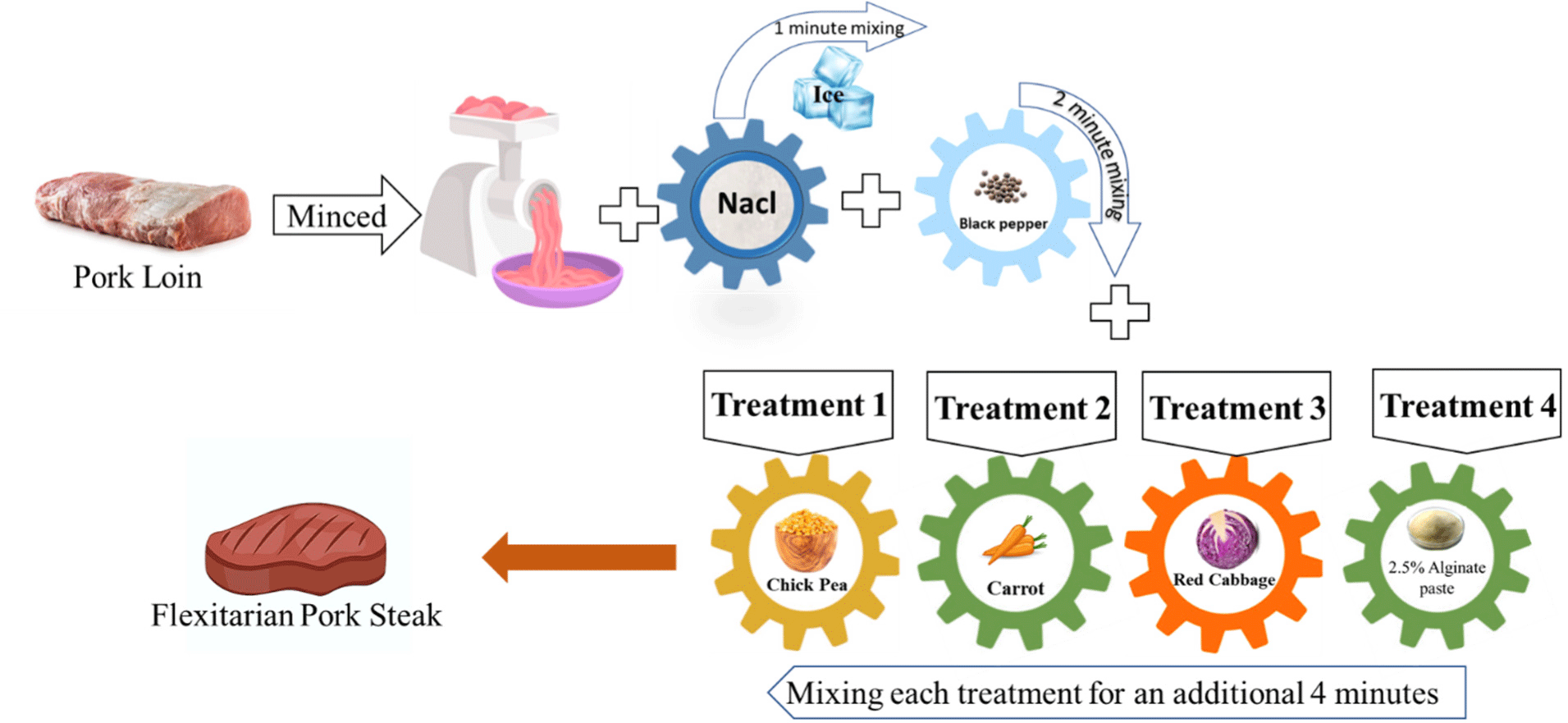Introduction
Consumers are attracted to meat products because of their distinct flavor, texture, and nutritional benefits (Cardona et al., 2023). Due to technological advancements, meat consumption is more integrated into people’s everyday diets. According to the OECD and FAO (2021), global meat protein consumption is projected to increase by almost 14% in the next ten years, primarily due to rising income and population growth. The increasing demand is closely connected to a variety of obstacles, including public health and environmental challenges, as well as concerns regarding animal welfare and ethical integrity. But considering these issues, it is difficult to completely stop meat consumption by meat lovers, as it would be challenging because many derive pleasure from consuming meat and hold the belief that it offers significant nutritional advantages (Dagevos, 2021). There are alternative options are under development like cultured meat (Post et al., 2020), hybrid cultured meat (Alam et al., 2024), hybrid meat (HBM; Baune et al., 2021), plant based meat (Kumari et al., 2023), restructured meat (Samad et al., 2024). to address meat related health and environmental consequences.
A sustainable approach for meat lovers could be the hybrid flexitarian meat diet as the most exemplary model of a planetary healthy diet. The adoption of a flexible diet that reduces meat consumption, commonly referred to as ‘flexitarianism’, is expected to facilitate weight loss and provide metabolic health advantages such as the decreased risk of diabetes and lower blood pressure (Derbyshire, 2017). This can be achieved by embracing a diet rich in plant ingredients with a moderate intake of animal protein sources including beef, lamb, pork, chicken, poultry, eggs, and fish (EAT-Lancet Commission, 2019). Flexitarian eaters reduce the quantity of meat portions while increasing their intake of plant-based proteins and other vegetables (Kemper and White, 2021). HBM flexitarian diet could be a promising solution for many consumers as a means to reduce their carbon footprint and look after their health (Veganz, 2020). Health plays a significant role in motivating consumption (Kemper and White, 2021) and reducing meat intake is associated with perceived benefits such as weight control, reduced saturated fat, and illness prevention (Cheah et al., 2020).
HBM is likely to associated with the flexitarian consumers and provide as a compelling option for flexitarians seeking to decrease their meat intake (Profeta et al., 2021). HBM could a reformulated meat product option to contain reduced levels of fat, sodium, and additives, while also being enriched with functional ingredients like dietary fiber and bioactive compounds (de Souza Paglarini et al., 2019; Souza et al., 2019). The incorporation of dietary fiber into meat products is crucial due to the absence of this component in meat, despite its exceptional nutritional profile (Das et al., 2020). The reformulation of meat products with the inclusion of dietary fiber becomes crucial as meat, despite with its good nutritional content, is not considered a source of this nutrient (Das et al., 2020). HBM products are a beneficial approach of integrating plant proteins into conventional meat recipes, given the current market emphasis on partially reducing the amount of red meat used. In addition to enhancing nutrition, the inclusion of dietary fibers in the formulations can result in cost reduction, provided that they effectively substitute lean meat and animal fat (Mehta et al., 2015).
Several studies with HBM products have examined use of varying levels of plant ingredients, such as, oat fiber (Souza et al., 2019), pea protein (Pietrasik and Soladoye, 2021), extruded pea protein (Broucke et al., 2022) etc. HBM products can be efficiently prepared with combined use of multiple ingredients, such an effort was taken to produce HBM pork meatballs, replacing 70% meat with extruded pea, sunflower, and pumpkin proteins (Baune et al., 2021). Carrot has been tried as dietary fiber in restructured dry fermented sausage up to 12% and results suggested an optimum value around 5% to maintain physicochemical and textural parameters (Eim et al., 2013), but further study is required regarding the inclusion level. Carrot is known as a beneficial vegetable and enhanced the nutritional and health properties of reconstructed beef hamburger when included at 6% levels (Soncu et al., 2015). Similar studies recognized carrot juice to enhance safety characteristics and well received during sensory panel at an inclusion level of about 20% (Badr and Mahmoud, 2011). Plant fibers (fermented spinach extract) were utilized as a meat substitute to enhance bacterial count in cured pork loins (Kim et al., 2017). Addition of spinach powder treatment found to enhance the oxidative quality of beef fermented sausage (sucuk) in a different study by inhibit the formation of thiobarbituric acid (Palamutoğlu et al., 2018). Plant proteins are commonly used ingredients in HBM or RM products. Chicken sausages made successfully contained a blend of soy protein isolate, gluten and chickpea flour replacing 40% of meat (Kamani et al., 2019). Replacing large amounts of meat in HBM products sometimes found to have negative sensory characteristics in respect of flavor and texture (Argel et al., 2022; Chandler and McSweeney, 2022), so the ideal inclusion level of plant ingredients needs continuous further study.
Considering these relevant aspects, this study aimed to evaluate the effects of dietary plant ingredients (red cabbage, carrot, yellow pea and alginate) on the physicochemical and sensory properties of HBM pork loin steak. In addition, create a delicious and nutritious flexitarian HBM product to reduce their meat consumption and have a minimal environmental carbon footprint.
Materials and Methods
The first step of this study aimed to select plant ingredients to apply in HBM steaks according to their technological and sensory properties. To achieve this objective, the experimental design is presented in Table 1 showing four formulations of the meat steaks performed by pork as control and four treatment formulations with 30% plant ingredients: 2.5% alginate paste, red cabbage, carrot, and chickpea (named TAG, TRC, TCA, and TCP respectively). Pork loin meat, red cabbage, carrot, yellow pea, salt, and spices were purchased from a local supermarket shop in Jinju, Republic of Korea. The chickpea was soaked in water for 24 h before use. Soaked chickpea was made into paste with a food mixer (Philips Mini Blender HR2602/10, Amsterdam, The Netherlands). Carrot and cabbage were cut into small pieces and made into paste with the same food mixer. For making the TAG, 2.5 g of sodium alginate powder (Sigma Aldrich, MO, USA) was slowly added to 100 mL double distilled water in a glass beaker put on a stirrer until the thick paste is formed. All these pastes were kept at 0°C–2°C till making the steaks.
The Pork loin meat was cleaned to remove fat and minced using an electric meat grinder (KitchenAid, St. Joseph. MI, USA) and gradually the ingredients were mixed in the following order: sodium chloride, and ice were mixed for 1 min, then black pepper was added and mixed for 2 min. Finally, the treatment ingredients were mixed properly as per the formulation in Table 1 for the last 2 min (completing the processing time of 7 min). Pork steak and HBM steaks were formed in a dimension of 6 cm L×4cm W×1cm D with an average weight of 50 g in triplicates.
The formed raw steaks were kept at –20°C for 2 h to conform to firmness. Individual steaks were fried with sunflower oil in a frying pan at 180°C until the internal temperature of the samples reached 80°C (approximately 15 min) before served to the sensory panel. The schematic representation of the flexitarian pork steak manufacturing has been illustrated in Fig. 1 for better understanding.
The moisture content was determined following the standard of AOAC (2002). Approximately 2±0.05 g sample in triplicate was dried on an aluminum dish at 105°C for 16 h using an automatic oven (BF-150C, BioFree, Buchen, Korea), transferred to a desiccator, and calculated using the following formula.
A digital pH meter (Orion StarTM A211 Benchtop pH Meter, Thermo Fisher Scientific, Waltham, MA, USA) was applied to evaluate the pH of the steaks triplicate. The probe was calibrated at 25°C with calibration solutions at pH values of 7.00, 4.01, and 9.99 prior taking the readings. Approximately 3±0.05 g of control and each treatment sample was mixed with 27 mL of deionized water and then homogenized (IKA T25 ULTRA-TURAX, IKA-Werke, Staufen, Germany) for 30 sec.
Color parameters of the steaks were evaluated in triplicate using a colorimeter (CR-300, Konica Minolta, Osaka, Japan). The colorimeter was standardized before taking readings with a white plate (Y=93.5, X=0.3132, y=0.3198) before measuring CIE L*, CIE a*, and CIE b* at three different areas (center and edges) of the steaks.
Releasing water content (RW)% was evaluated in control and treatment steak samples in triplicate following the methodology of Joo et al. (2002). HBM steak sample weighing approximately 3±0.05 g was placed on a filter paper (Whatman No. 1) with a diameter of 11 cm. The filter paper was covered with two thin plastic films sheets. The meat samples were sandwiched between plexiglass plates, with filter paper and plastic film sheet, and subjected to a constant pressure of 2.5 kg for 5 min to facilitate water release. Finally, the percentage of RW was calculated as follows:
Crude fat (CF) content of the samples were determined by applying a modified method of Folch et al. (1957). For CF extraction approximately, 3±0.05 g of homogenized steak sample treated with 30 mL of Folch solution (chloroform: methanol=2: 1, v/v). The homogenized samples were then going through filtration (Whatman no.1 filter paper). Later 8 mL of NaCl (0.88%) was added in the filtrate and then vortexed for proper mixing. A resting period of 12 h was applied and then the top layer was removed with aspirator machine having vacuum pressure with a glass pipette. Afterwards, the left bottom layer was transferred to pre-weighed aluminum dish to dry at 50°C in a hot air oven. Finally, the CF content was measured using the weight differences of both empty and dried aluminum dishes and calculating with the following formula.
The cooking loss (CL) of the steak samples was assessed in triplicate by measuring the percentage of weight loss. This was done by placing the steak sample weighing approximately 25±0.05 g and measuring 1.5 cm in thickness, in a poly zipper bag. The samples were then heated in a water bath at a temperature of 75°C for 30 min. Subsequently, the samples were allowed to cool to ambient temperature and held for 30 min to remove any excess moisture from the surface. The calculation was performed according to the following formula.
The same samples from CL were subjected to the determination of shear force value (WBSF, kg/cm2). For this, an Instron Universal Testing Machine (Model 3343, Instron, Norwood, MA, USA) with a V-shaped shear blade was used and measurements were taken in triplicate. The sample was cut to a size of width 0.5 cm×length 4.0 cm (about 2.0 cm2) before proceeding to measure the shear forces. The crosshead speed was set at 100 mm/min. The maximum scale load was 50 kg.
The visual characteristics of cooked and uncooked steaks were evaluated according to method of Wi et al. (2020). The physical visuals were captured using a digital camera (Canon EOS 700D, Canon, Tokyo, Japan) and the textural differences were noted.
A trained panel of twelve researchers from the Department of Animal Sciences at Gyeongsang National University, Republic of Korea were recruited to assess the sensory characteristics. The selection of panelists was conducted in accordance with Lawless and Heymann (2010), adopted by Choi et al. (2014). HBM samples were made like cubes by cutting 2 cm in all three dimensions, assigned with a random coding serial, and served on a Pyrex® glass container. Before sensory evaluation, the samples were kept in rest for 30 min at room temperature. The panel assessed each treatment three times under fluorescent illumination. The panel members were given drinking water to clean their mouths to remove previous samples between each sensory evaluation, along with the samples. The sensory attributes of cooked steaks were evaluated using a 1–9-point hedonic scale for different parameters in terms of flavor, juiciness, tenderness, chewiness, and overall acceptance. On a 9-point hedonic scale, the assessment criteria were as follows (1=extreme dislike, 9=extreme like). The approved consent procedure for sensory evaluation is Institutional Review Board (IRB): GIRB-E24-NY-0116. The signed consent from all the panelists was taken before the sensory evaluation.
Electronic tongue analysis of the samples was conducted using an electronic tongue system (ETS; INSENT SA402B Electric Sensing System, Insent, Tokyo, Japan) following the method developed by Ismail et al. (2020). The ETS system primarily comprised of sensor arrays, electrodes, data analysis software, and specialized artificial lipid membranes. The ETS has the ability to differentiate between five distinct flavors based on their flavor identification characteristics. Each measured parameter was examined once all membranes were stabilized in a standard meat taste solution (SMT). The SMT solution consisted of 0.01% lactic acid for sourness, 0.25% monosodium glutamate for umami, 0.0005% quinine hydrochloride for bitterness, 0.55% sodium chloride for saltiness, and 0.8% sucrose (sweetness). Approximately, 100±0.5 g of sample was combined with 400 mL of hot double distilled water (95°C; 20 min). The mixture solution was centrifuged for 15 min at 1,000×g, and the sediment was collected by filtering and preserved at –70°C for subsequent examination.
The perceived data underwent statistical analysis using one-way analysis of variance (ANOVA) using SAS 9.4 (SAS Institute, Cary, NC, USA). Duncan’s test was performed for multiple mean comparisons. A complete randomized design was utilized for statistical analysis. Results are expressed as least square mean values of three independent replications and SE used in case of the error terms. A p-value of ≤5% was considered significant. For principal component analysis (PCA), the data were arranged by putting the treatments in rows and all variables in different columns using Metaboanalyst 6.0 software; the score plot exhibited the separation of the principal components based on the treatment effect and the biplot displayed the individual concentration correlation and normal distribution to confirm their suitability for PCA analysis.
Results and Discussion
The color and pH values obtained from the control and HBM steaks are given in Table 2. Significantly (p<0.05) lower pH (5.75) of control (pork steak) was observed in the raw form compared to the HBM steaks (5.79–5.94). But after cooking pork steak pH (5.97) was higher (p<0.05) and in the case of HBM steaks pH (5.67–5.85) decreased (p<0.05). The high pH in the raw HBM steaks were could be due to the natural alkaline state of plant ingredients (pH 5.66–5.84) as opposite to pork meat (Kamani et al., 2019). Additionally, the reduction pH value of pork steak could be generated from postmortem glycolytic changes which is a common phenomenon in meat (Chauhan et al., 2019). In previous research utilizing chicken sausage has demonstrated a consistent increase in pH values when partially or fully substituted with plant ingredients with is consistent with present study findings (Kamani et al., 2019).
Similarly, like pH and colorimetric measurements are interrelated and in this study the inclusion of plant ingredients in HBM steaks TAG, TRC, TCP significantly (p<0.05) increased CIE L* than pork steak. For TCA CIE L* was less due to natural purple color. The CIE a* values differ (p<0.05) between the treatments and in TCP it was lower may be due to the yellow color of the chickpea. Nevertheless, the pork steaks as control may had a higher degree of myoglobin denaturation, as seen by the diminished CIE a* value during the cooking process. Similarly, water can induce greater light reflection, thereby contributing to the current study scenario of significantly (p<0.05) higher CIE L* in HBM steaks as compared to control as supported by Akesowan (2010), who observed similar results to the current findings, with a trend towards decreased CIE L* values and increased CIE b* values in pork patties that were treated with soy protein. Furthermore, the integration of variable colors of plant ingredients like purple color of cabbage, red color of carrot and yellowish color of chick peas can remarkably responsible for the significant (p<0.05) color variation of the HBM steaks. The increased CIE b* values resulting in more CIE b* of the HBM steaks can be associated with the high moisture and light base colors of the plant ingredients. Prior research has determined that the yellowish-brown tint has an impact on the overall quality of the end product (Kyriakopoulou et al., 2019).
Table 3 illustrates the additional physicochemical properties like moisture, CL and RW for HBM steaks and control. In the current study, pork steak had lower (p<0.05) moisture content (71.12%) followed by higher moisture (72.48%–74.76%) in TAG, TRC, TCA and TPC. Pork loin steak moisture content was similar to Lee et al. (2016). This was supported by the study from Patel et al. (2022), where the addition of plant ingredient carrot was found to significantly in moisture% with increasing inclusion level. Pork steak demonstrated elevated (p<0.05) level of CL due to denaturation of connective tissue and fluid, especially moisture and fat loss followed by other HBM steaks steak except TAG, due to substituted with plant protein remarkably. As alginate is known to have high binding ability (Kang et al., 2020), TAG steaks had the lowest CL and RW. Prior research has suggested that incorporating dietary fiber and meat proteins into food preparations can potentially minimize the extent of CL and weight loss that occurs during the cooking process (Johnson, 2022; Samard and Ryu, 2019). TRC and TCA showed higher (p<0.05) RW followed by pork steak, TCP and TAG. The reduced fat content in plant protein allows the protein to readily attach to the water molecules, leading to an increase in RW (Johnson, 2022) as observed in TRC and TCA. TAG and TCP might have lower RW due to better binding ability.
Fig. 2 illustrates the WBSF shear force values of the pork steak and HBM steaks. WBSF values demonstrated that HBM steaks exhibited lower (p<0.05) toughness compared to pork steak, but in case of TAG it was closer to pork steak, may be due to strong binding ability (Kang et al., 2020). The increased hardness in pork steak was anticipated as a result of the denaturation of muscle proteins, leading to greater values of WBSF shear force in the meat, finally resulting in tougher meat (Ismail et al., 2019). The relatively less tough textural properties of plant ingredients in HBM steaks significantly affected their shear force values. The WBSF of plant ingredients-based meat products has shown similar lower shear force value in chicken meat in other studies (Wang et al., 2023). The outcomes of the present investigation align with those of Danowska‐Oziewicz (2014), who likewise observed reduced WBSF values in products made with soy protein isolate compared to whole pork patties.
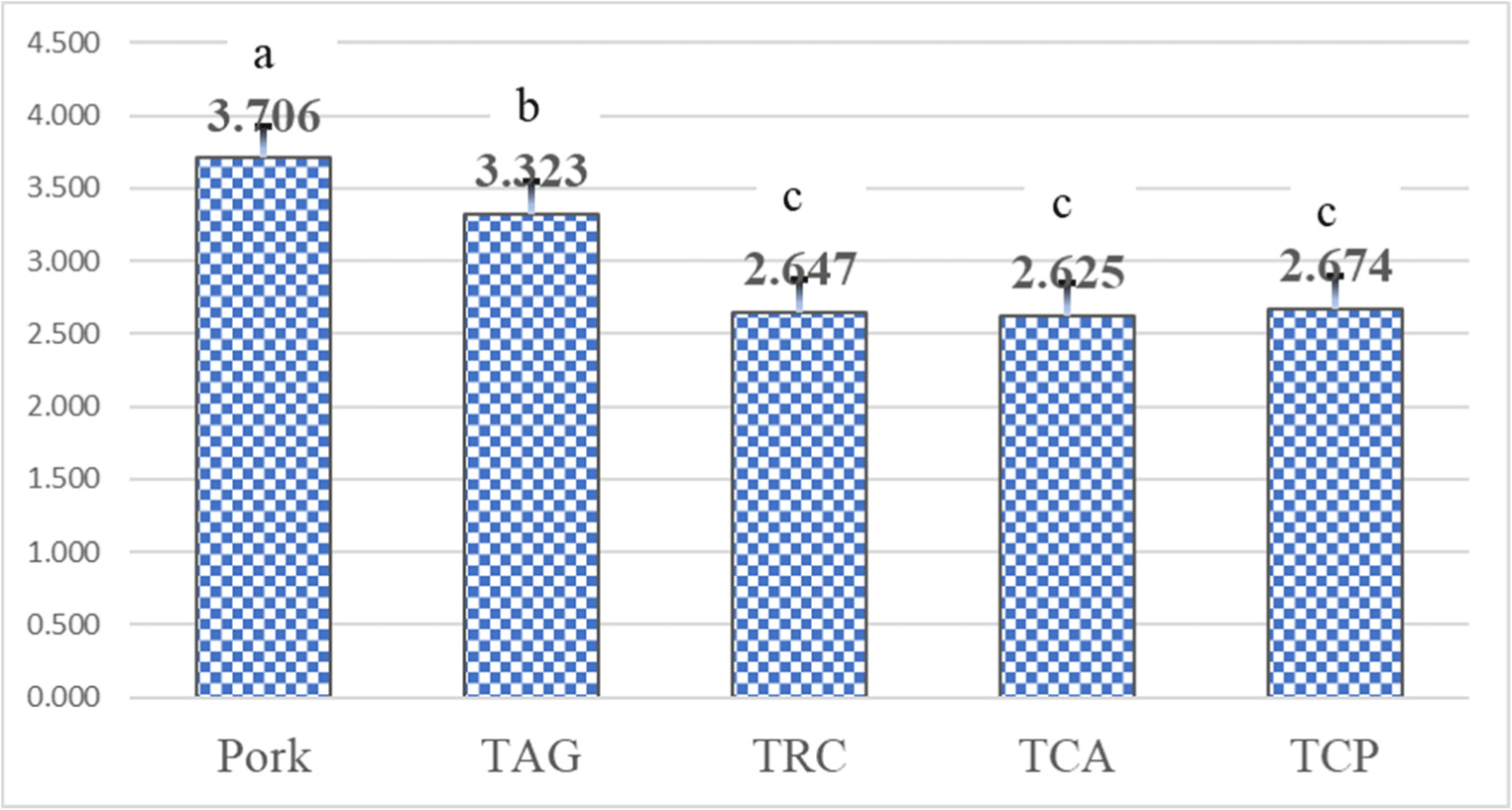
The CF content in HBM steaks possibly due to the plant ingredients having usually low-fat content. Fig. 3 demonstrates that the CF of control and TAG steaks are significantly (p>0.05) higher than the other HBM steaks. This is usual for pork as it is usually containing more fat (Hoa et al., 2021) and for TAG higher fat content could be due to better binding ability of sodium alginate (Kang et al., 2020), which may bind the fat better than other ingredients. Other HBM steaks had lower CF content, but did not have significant difference between them. In previous studies similar lower fat content was found in meatballs having plant ingredients like red lentil (Rohmah et al., 2023). This study’s lower fat content in HBM steaks is due to the addition of plant ingredients as found in studies by Chan et al. (2019).
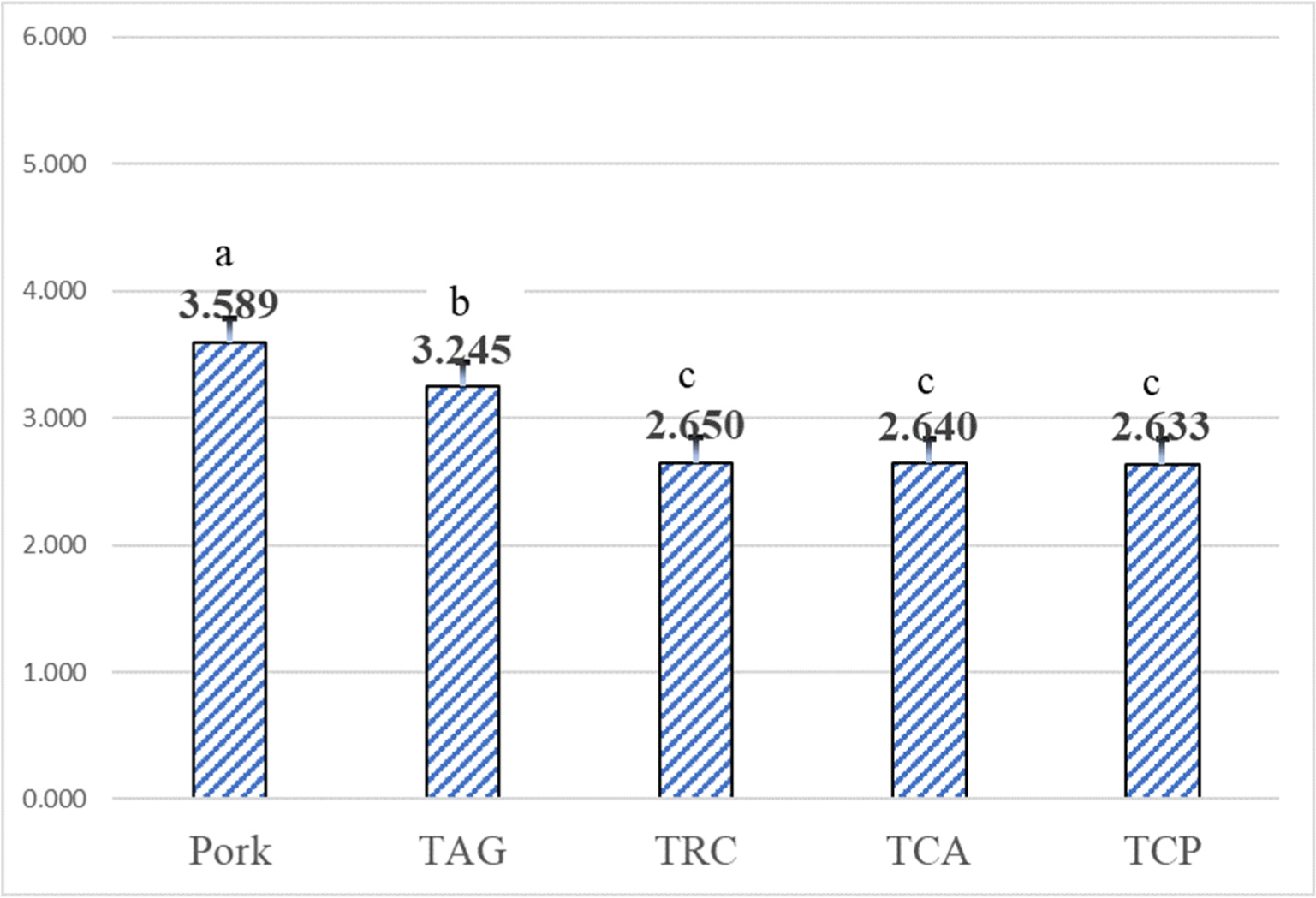
Visual physical appearance of HBM steaks compared to pork steak are shown in Fig. 4. There was no notable difference on the external and internal appearance of pork steak and HBM steaks. Nevertheless, control (pork steak), TAG, TCP had similar kind of less porous and rough structures before and after cooking. On the other hand, TRC and TCA had slightly porous and rough structure after cooking and this can be explained by the high fiber content in red cabbage and carrot. In overall observation all ingredients showed better mixing ability with pork meat. Prior research has determined that the primary disadvantage of utilizing plant-based materials such as textured vegetable protein in the formation of patties with a resulting granular surface (Bakhsh et al., 2021). However, it was observed in the same study that both the exterior and interior appearance of all patties became more uniform and cohesive as the concentration of meat was raised. However, it was, which was absent here and made the plant ingredients promising for HBM product manufacturing. More research is needed on the evaluation of different plant-based ingredients for inclusion in HBM formulations for development of suitable products for flexitarian consumers.
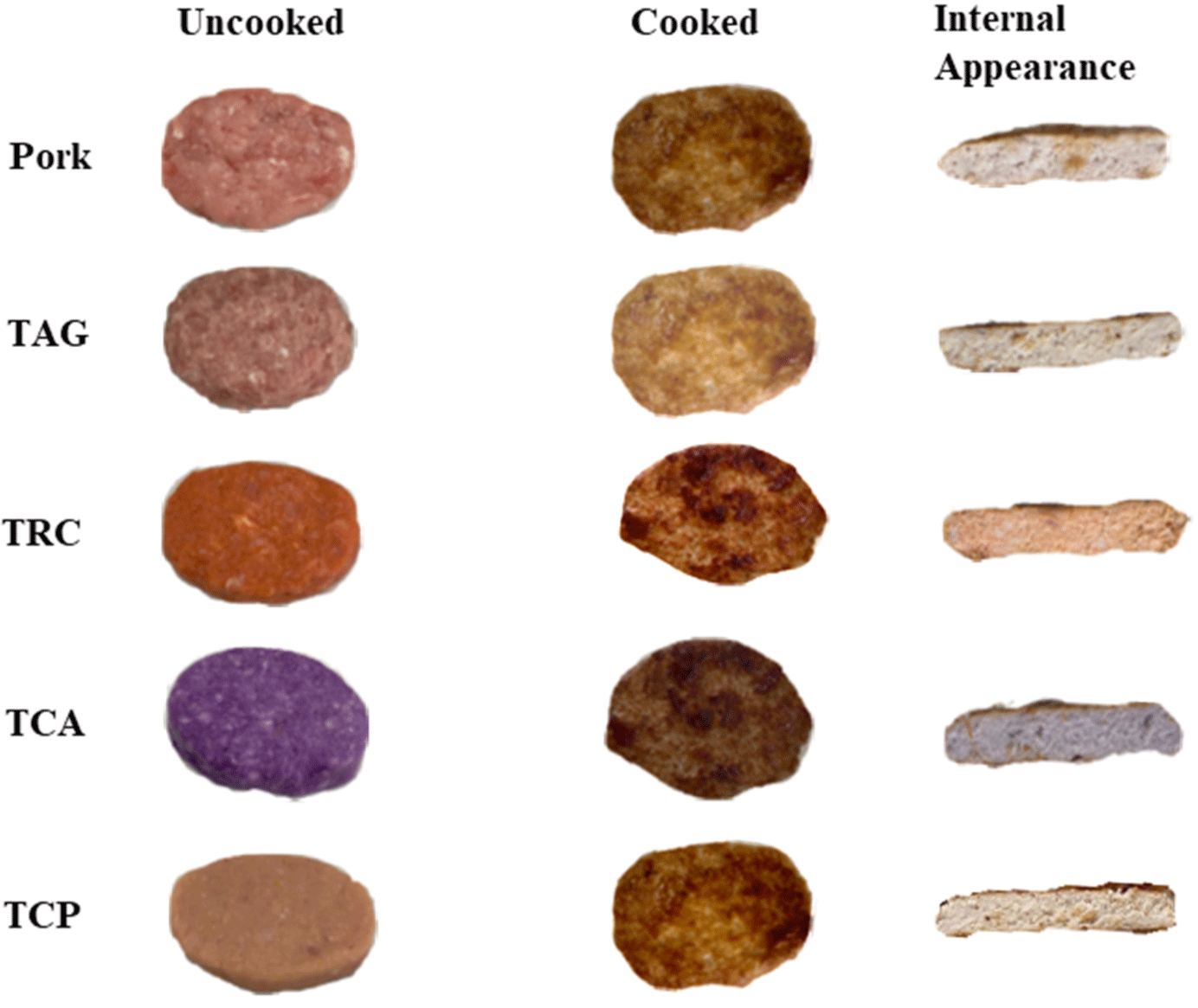
The results of general cooked sensory traits of pork and HBM steaks are shown in Fig. 5. The detailed values are given in Table 4 for further reading. The flavor found better (p>0.05) in pork and TCA than other HBM samples. TRC and TCA had higher (p>0.05) score for juiciness other treatments. The tenderness was better (p>0.05) in TAG and TCP than in control and other treatments. The pork steak and TAG felt slightly harder (p>0.05) during chewing than other treatments. The overall score was the higher (p>0.05) for pork steak and TAG followed by TRC and TCP. In case of TCA overall acceptance score was lower (p>0.05). Sensory panel commented TCA could be an ideal formulation for kids. The variability of HBM steaks as compared to control could be due to the inclusion of plant ingredients (Bakhsh et al., 2021; Wi et al., 2020). The positive outcome of this study was, none of the panelist detected any presence of beany essence in the current investigation.
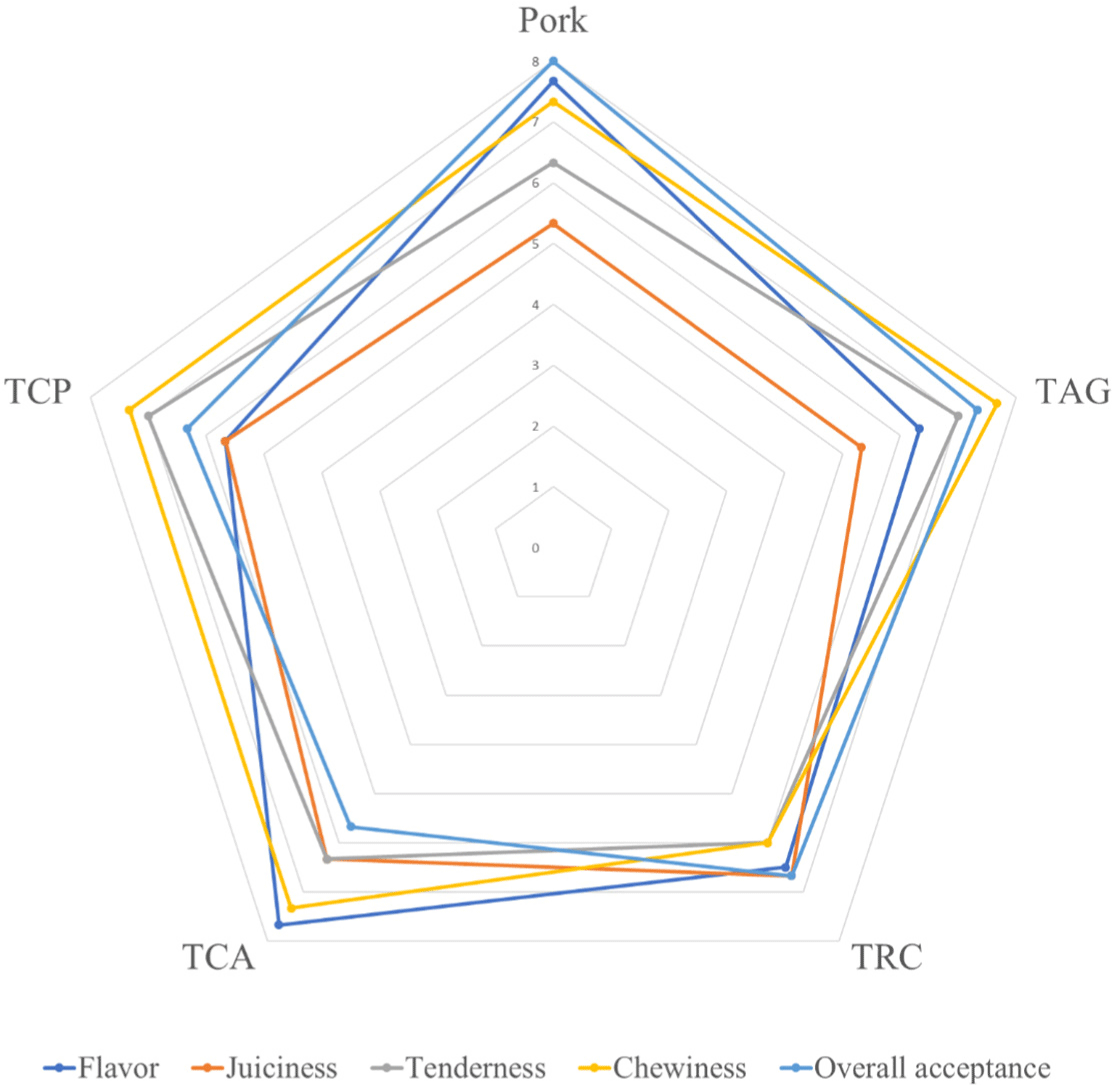
The results from ETS are illustrated in Fig. 6. The results revealed that except TAG other samples had negative sourness values. Bitterness value was lowest (p>0.05) in pork and plant ingredients shows higher (p>0.05) bitterness. Umami characteristics were found higher (p>0.05) in TCA followed by TCP, TRC, TAG and pork steak. Richness value for pork steak was higher (p>0.05) followed by TAG, TCP, TRC and lowest in TCA. Higher bitterness in TCA could be due to the natural off flavor and taste that persist in cabbages. Overall umami and bitterness characteristics were higher in HBM steaks and this may be due to volatile chemicals typically present in plant ingredients and those may contribute to a variety of smells and aromas (Asgar et al., 2010). Therefore, a diverse range of spices and herbs, including those commonly used in meat processing, are used to imitate the flavors found in processed meat. Nevertheless, a lingering taste can still be discerned in numerous plant-based substitutes. The presence of a distinct smell. Commonly associated with beans, is believed to be caused by secondary lipid oxidation products or derivatives (Boatright and Lu, 2007). The natural presence of saponins and isoflavones contribute to the bitter and astringent tastes. These characteristics may pose a challenge to the use of soy derived protein as a primary ingredient of meat alternatives (Boatright and Lu, 2007).
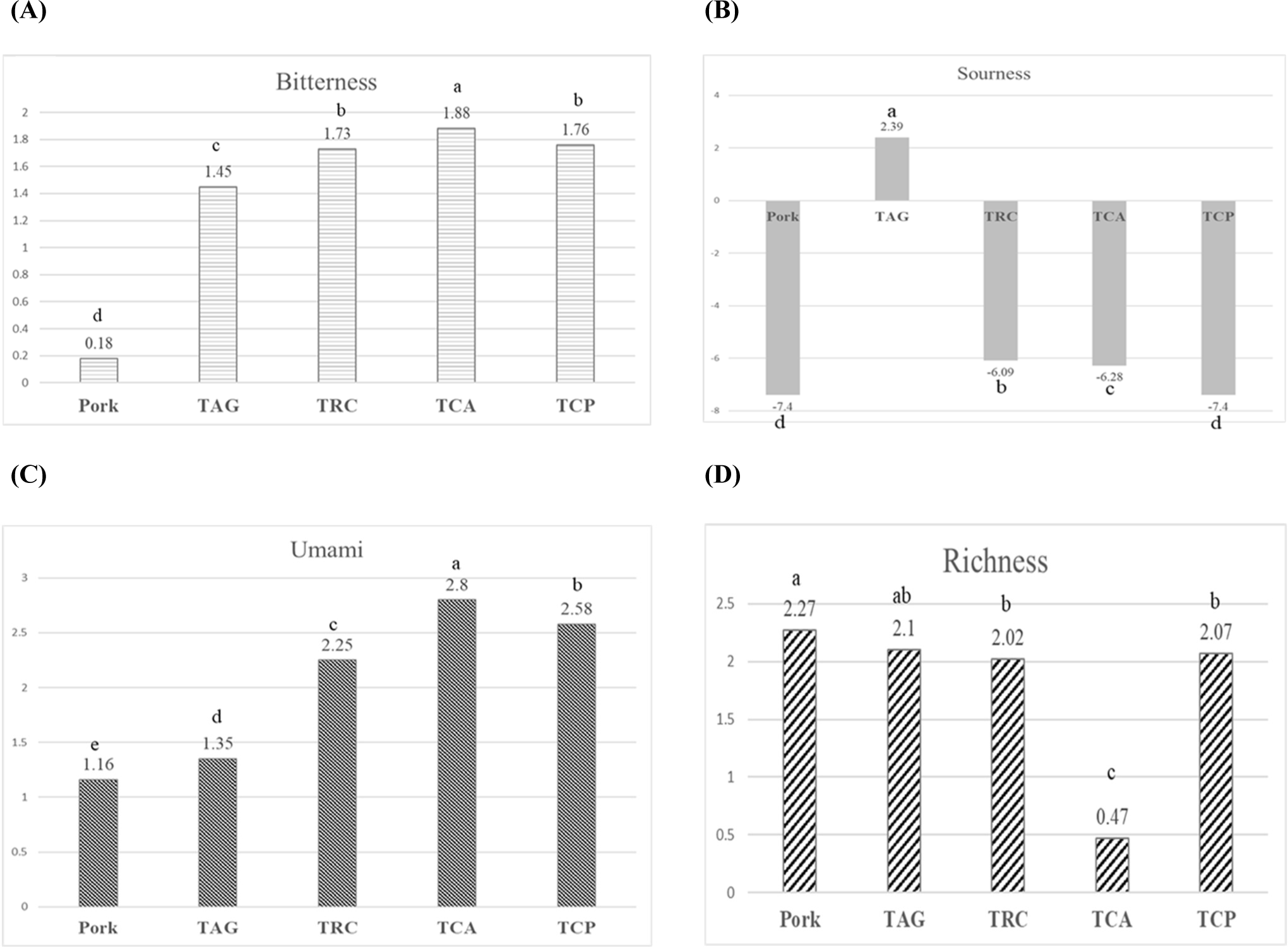
Briefly, to explain the association of physicochemical parameters of pork and HBM steaks, all data were used for PCA, which demonstrated the difference between the control and HBM steaks. Figs. 7A and B displays the score plot and biplots for the discrimination of the pork steak and HBM steaks based on the analyzed variables. The PC1 and PC2 of the analyzed data comprised 62.6% (17.7% and 44.9%) of the total variance, effectively demonstrating the association of plant ingredients in different HBM steaks. Moreover, the TRC and TCA clustered (Fig. 7A) as a demonstration of differentiation from pork steak, TAG and TCP. The biplot (Fig. 7B) describes the gross visualization of the PCA score and loading plots. The cooked and raw samples in terms of pH and CIE L* were highly correlated. Thus, the PCA aids understanding of different clusters based on the variances and quality parameters involved in the separation of pork steak and HBM steaks directly correlated with the moisture, pH, color, CL, RW and shear force.
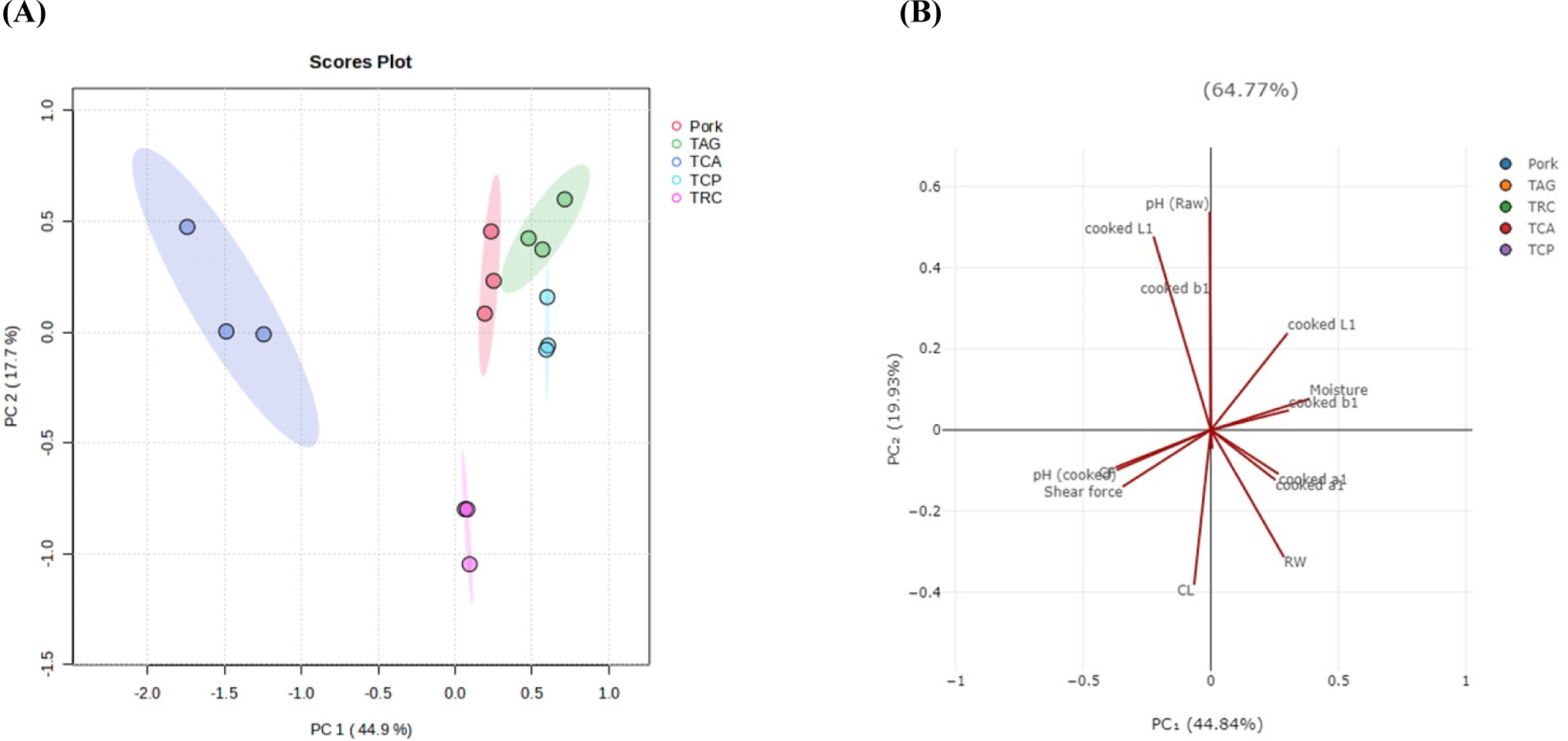
Conclusion
Physiochemical characteristics of the HBM demonstrated elevated pH levels and decreased levels of CIE L* and CIE a*. Additionally, the HBM showed lower fat content and softer texture compared to pork steak. Pork steak, however, demonstrated increased level of toughness and reduced RW in comparison to the HBM steaks. The favorable treatment for HTBP was added with TAG, TCA and TCP which produced better sensory qualities such as attractive colors and denser textures. Moreover, TAG and TCP had better physicochemical profile compared to pork steak and additionally higher scores in sensory evaluation. HBM steaks with plant ingredients like alginate, chickpea, carrot could be healthy meat-based products having low-fat content. Therefore, in order to produce a quality HBM suitable for flexitarian consumers of pork plant-based protein ingredients are promising, but need further study to evaluate usage percentage and detailed nutritional profile like secondary metabolites to assess the functional qualities.














